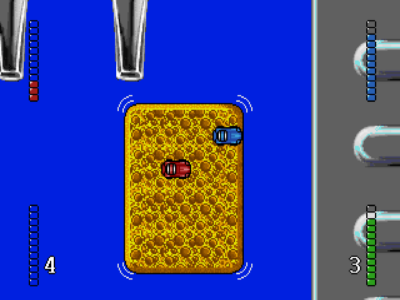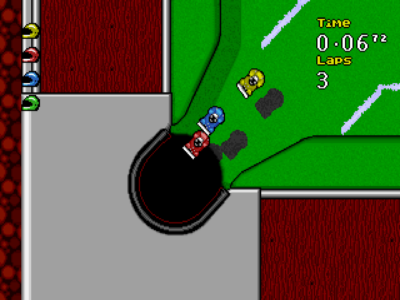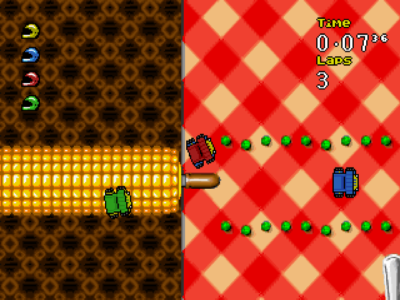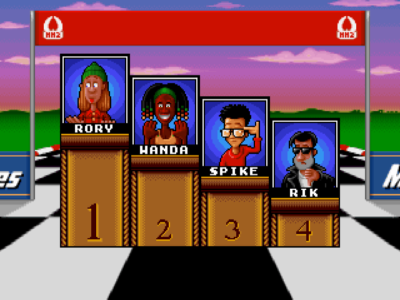
Micro Machines 2
Written by: Rik
Date posted: July 23, 2009
- Genre: Racing
- Developed by: Supersonic
- Published by: Codemasters
- Year released: 1995
- Our score: 7
In general, my gaming upbringing has been with computers rather than consoles. As a result, I’m now what you might call a bit of a PC snob, the type seen shrugging with indifference at news of whatever might be causing a stir in the world of Xbox, reasoning that if it’s at all half-decent, it’ll come to PC eventually, and then we’ll see whether it’s worth any of our precious time. There’s a Street Fighter IV, you say? Yeah, we can play that too – but we can’t be bothered.
Rewind fifteen or so years, though, and as a less cynical young man, there were occasions when the bright lights of the console world appeared more than seductive. In stark contrast to my metaphorical shrugging at the fourth game in the series, in the early 90s I would have given anything to be able to play Street Fighter II at home – the proper, arcade-perfect version with console joypads, mind you, not the depressing, slow-motion affair that I had to endure on my Atari ST with an unresponsive one-button joystick.
So different were the two renditions of this game, it was hardly surprising that the many hours of gameplay I racked up at home served as next to useless practice for the many multiplayer tournaments on my friend’s Megadrive that served as a weekend’s entertainment during my teenage years. Still, although the numerous beatings did hurt my pride after a while, there always seemed to be a random element to the fighting that meant you had more chance randomly mashing the buttons than repeatedly trying, as I did, to successfully execute a dragon-punch (I never managed it, I don’t think).
My competitive spirit, and desire to own a Megadrive, was more easily fired by this game, which proved compelling and frustrating in equal measure as I suffered defeat after defeat to people who actually had the chance to practice during the week. Suffice to say, Micro Machines 2 never got a release on the Atari ST, but, after a delay significant enough to see our family purchase a PC and for me to have stopped talking to my Megadrive-owning tormentors, it finally made an appearance (around the same time, coincidentally, as a pretty decent port of Super Street Fighter 2 Turbo ) on the best system of them all. So suck it, console boys.
Ahem. In fact, the original Micro Machines had already had a fairly low-key release on PC, some years after the success of the initial NES version. If you’re wondering what that one was all about, it was largely similar to the game I’m about to describe – a top-down arcade racer, based upon the once-popular scale miniatures of the same name, centred around various Honey I Shrunk The Car scenarios such as, for example, driving around the breakfast table – but with slightly less-impressive graphics and fewer features. The PC port was a fairly scrappy, minimal effort affair, too, which was probably a reflection of the amount of interest it was likely to garner from the PC gaming market at the time.

Taking the sponge-ferry in the kitchen – usually an excellent opportunity to slam your opponent into the drink.
Reason enough, in my book, to skip it and go straight to the sequel, which was both delivered and received with a whole lot more enthusiasm, and it loses nothing in comparison to the version released on consoles. In fact, the major difference between the DOSBox-powered version I’ve spent the last couple of weeks playing and the one I experienced during the halcyon days of my youth is the lack of multiplayer action this time around, with the late nights gathered around the TV with friends replaced with a more solitary experience, where the inevitable furious bouts of swearing are delivered to no-one in particular rather than in jest to a group of your peers, echoing around an empty house and reinforcing the grim truth that you’re angry and alone, and swearing only at yourself.
Truth be told, this is a game best enjoyed in multiplayer, where the battle is to get far enough ahead of your opponents to knock them off the bottom of the screen, win a point and restart from wherever the point was won. Once you’ve filled up your little bar with points, you win the round, and move onto another course of your choice. With one or more friends in tow, it can be gripping stuff, with most courses allowing plenty of opportunity for mishaps and mischief making before the winner is declared. Unlike other racing games, the stop-start nature of MM2 also means weaker players can keep up with the action and win the occasional point, rather than being forced to lag in last place for the duration.
In single-player, though, the game has less to offer, although it remains an interesting enough diversion. Four modes are offered: Challenge, a series of increasingly more difficult races against three AI opponents during which you must finish either first or second in order to progress; Head-to-Head, a version of the multiplayer game against a single AI opponent; Super-League, a series of races against opponents in a league system during which it is not imperative to finish first or second in any particular race but rather accumulate enough points over the course of four to progress to the division above; and, finally, Time-Trial, where you race around on your own trying to beat the best lap time on a track.
The first is where you’re likely to spend most of your time. It follows quite an old-school format in that there’s no way to save your progress, you lose a life if you don’t qualify and once you lose all your lives it’s game over and back to the start, but it’s reasonably good fun, although to the impatient modern gamer the appeal of having to trek through a load of races you’ve beaten already may start to wane after a while. Super-League is a pleasant enough variation, spreading the challenge across four races rather than one, but it’s still more or less the same game – a bunch of races you need to do quite well in that get progressively harder. Head-to-Head, meanwhile, may replicate the format of the multiplayer game, but while the AI does its best to irritate you, there’s no substitute for a human opponent. Time-Trial is largely pointless – the game isn’t about lap times, so there seems little purpose in trying to pretend that it is, although I suppose this does serve as a decent practice mode for tracks you may encounter elsewhere in the game.
There’s more than a few hours of fun here, and it’s mainly down to the ingenious design of the courses, with traps and obstacles dotted throughout each one to keep you on your toes. Whether it’s trying to avoid being knocked off a wooden plank by a drill bit, jumping onto a paint roller, or racing around a toilet seat, the potential for a calamity remains throughout. It has to be said, though, that the AI doesn’t make as many mistakes as you’d like, and even when it does it’s hard to take as much satisfaction from it as you would from witnessing a friend’s car plummeting towards the floor. This means, of course, that most of the time the calamities are happening to you, which is more frustrating than amusing, unless you happen to find your own disappointment and failure amusing. Which I don’t – I’m firmly in the ‘get angry’ camp.
In single-player, then, the appeal of Micro Machines 2 is fairly limited. Perhaps in an attempt to extend the longevity of the game for the lonely gamer, a construction kit has been included, which allows you to design your own courses using the pre-defined pieces, or by designing your own using a set of rudimentary painting tools. It’s certainly a decent idea, and it all works okay, but the feeling persists that you could patiently invest a week’s worth of evenings on your own creation and it would still be worse than anything included in the main game – which is, after all, made by professional game developers. Oh, and no-one would care either way.
Overall, lack of friends aside, Micro Machines 2 remains largely as I remember it, right down to the awesomely catchy menu music and the irrational desire to select the ‘cool’ character wearing shades and a leather jacket, in spite of the fact that he looks like a cross between the Fonz and George Michael circa 1987. Frankly, it’s pretty much the perfect version of this kind of game, and though there have been a couple of 3D sequels, they haven’t been anywhere near as successful or well-realised as this one.
On the other side of the coin, though, you’re only going to get the most out of it if you can convince some mates to get involved, which would be a hell of a lot easier if you had a time machine to take you back to 1995 (and possibly – whisper it – set up the Megadrive version in front of your TV). For those of you obsessed with this kind of thing, the score above represents the sporadically entertaining single player mode I was able to experience this time around. If you want to factor in the multiplayer, feel free to round up a little. Ok? Ok!





 Posts
Posts